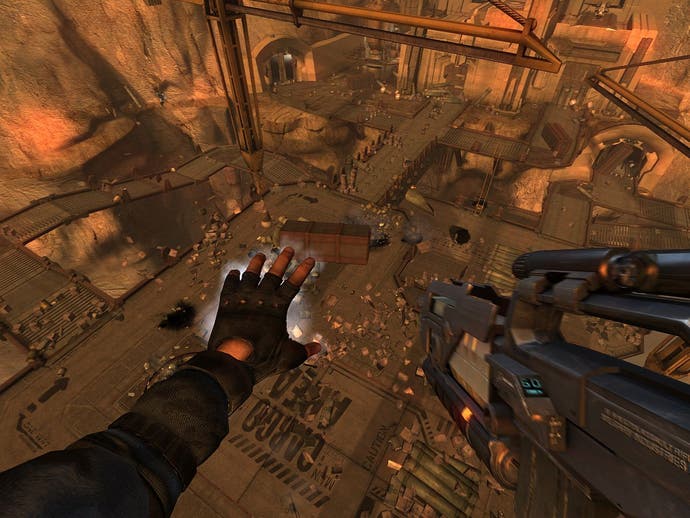Physical Education
What went wrong and what next for the beleaguered PhysX card.
The other problem is discretion and believability. Yes, that wine is spraying without bringing the PC's processor to its knees, but it looks weird and unconvincing. Similarly, Cellfactor's an environment full of PhysX effects, but watching a few dozen crates pinball unrealistically across the level like a lunatic charging headfirst at his foam rubber walls robs the game of coolness. There's just not enough discretion in PhysX's use - it's being wielded as a blunt instrument. Whatever its merits as a game, the reason Gears of War (which coincidentally uses the PhysX software engine) looks so much more graphically advanced than its peers is not because it's splattered high-dynamic range lighting and normal mapping absolutely everywhere just because it can. Indeed, its environments are pretty bland and interchangeable, but that doesn't matter because they're not where you're looking. It's carefully focused in on spending its tech and art on depicting its stars, a pack of really big men, in such a way that they look detailed and stylised at once, both real and unreal and, for all the insidiousness of the phrase, 'next-generation'.
By flailing around on as many crude exaggerations as possible, Cellfactor and Infernal don't impress in that respect - they're just a visual mess. If PhysX is to survive, it needs to focus in on a really thoughtful, jawdropping showcase. That showcase is actually already in Cellfactor - the occasional cloth banners that flutter impressively and can be shot to bits. Used as purely an incidental detail, they're totally wasted; a game in which characters wore actual, deformable clothing, rather than their clothing behaving as a part of their bodies, would be a different matter.

There's another way PhysX can be used, and that's best demonstrated in City of Heroes/Villains. It's a game that could really benefit from the pure excess the card is capable of - concrete dust spewing upwards from ruptured skyscraper roofs bearing the brunt of a superheroic landing, walls shattered by thugs' hurled bodies... Unfortunately there's none of that, but rather just an amplification of the game's existing physics, such as particle effects from energy beams and the amount of fragments the limited amount of smashable stuff in the mayhem missions shatters into. All of this is possible without the card, but if there is one in your system, it steps in and bears the processing brunt. As CoH is a game that taxes the CPU quite heavily, PhysX can mean a noticeable framerate boost if you're running the physics/particle settings maxed.
But that's in only one game, and not enough, sadly, to make the £120 and upwards expense of the card even vaguely logical over the rather more universal benefits of buying a dual core processor if you're still toting a single-core Pentium or Athlon. Unless you're so complacent in your evil-vanquishing abilities that counting the number of blue globes that appear around your guy's hand when he shoots is the only way to maintain interest in the game, dropping the settings down a notch or two makes very little noticeable difference, while performance improves significantly.
Which leaves PhysX hardware's fate hung very much on Unreal Tournament 3, due later this year. As the first truly A-list game that supports the tech, if the card really pulls its weight there it could mean a reversal in fortunes. After all, all the glowing energy orbs in the world won't make the ageing City of Heroes look deliciously high-tech, but doing its thing in a game with a cutting edge graphics engine might give PhysX the context it needs. At the very least, a £120 card could, for this game, be an easier and more tempting performance upgrade than a complete system refit, but that hangs on just how much it actually achieves come the day.

That, too, is under fire. 3D giants NVIDIA and ATI-AMD aren't about to let anyone else come and snatch a piece of gaming hardware pie, and are both incorporating physics tech into their new graphics cards. As their ripostes are in the form of jack-of-all-trades 3D cards rather than the dedicated nature of PhysX, these don't have quite the same performance potential for physics, though they remain an unproven force as yet. What they do have, though, is a much larger install base, one that developers can code fundamental rather than inconsequential physics effects for in relatively secure knowledge that there'll be enough people able to use them to make the effort worthwhile. The gradual rise of quad-core and beyond CPUs is another a nail in the coffin PhysX seems to be being buried alive in - again, they won't be dedicated physics processors, but they'll be universally-installed hardware with headroom to spare.
If PhysX dies, it won't be because the hardware has failed; it hasn't. It'll be because it was a small fish in a small pond already filled with sharks. It's Beagle Two up against NASA, and while you have to admire its pluckiness, its homemade, tinfoil and sellotape approach was never going to be able to compete with infinitely rich giants that could turn its ideas into just one tiny mass-produced component amongst thousands.








